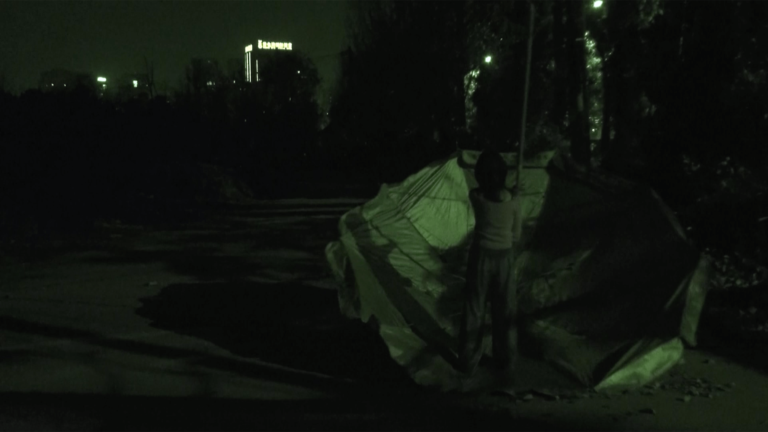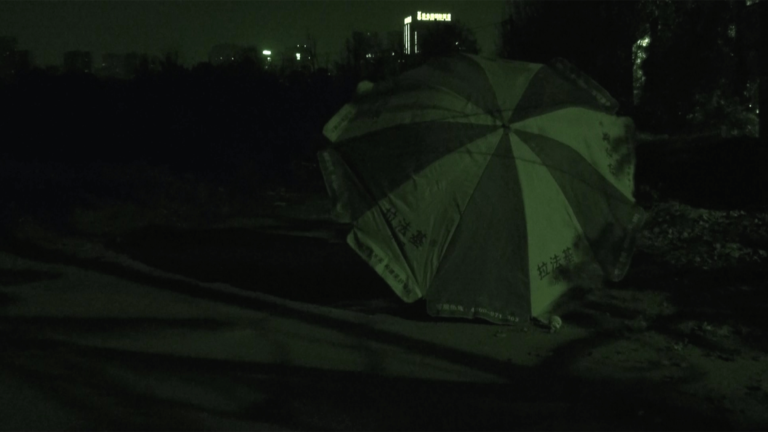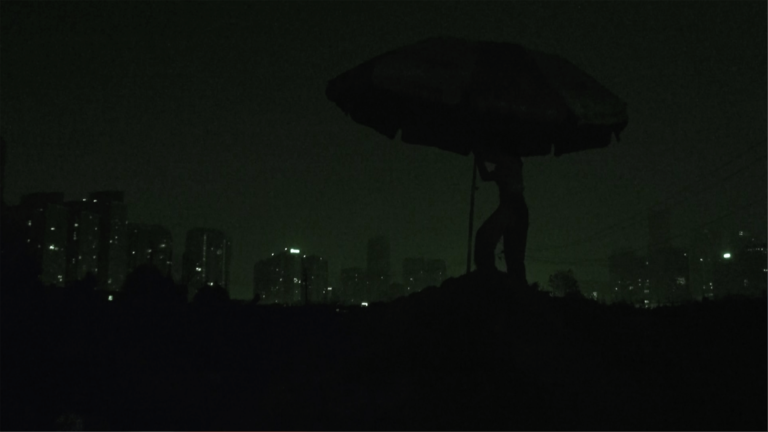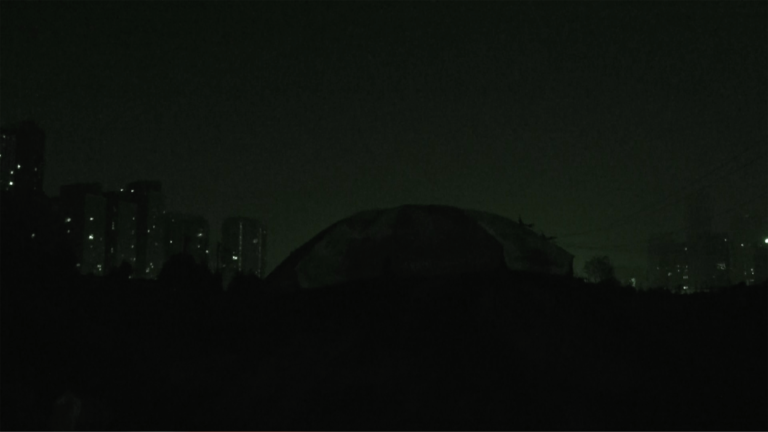杨然Young Ran




基地Base
我相信一切的事件都会成为一种记忆和想象,回忆会越来越晦涩和未知。
我相信宇宙的坍塌和扩张正在同时靠近。
这个行为,是对100年后,人类开辟的另一个太空世界的回应。
从动物到上帝,我们正在明白什么是人类。
What I believe is that all things will become a kind of memory and imagination.
And the memory will become more and more obscure and unknown.
I believe that the collapse and the expansion will be approaching at the same time.
The act is a response to another space which is created by human in 100 years. From animals to the god, we are learning what human being means.
在艺术品中找到意义
Finding meaning in the artwork
黑暗中的雨伞
彭旭
在影片的初始,我们看见艺术家在黑暗中出现,从昏暗的角落中撑起一把巨大的伞。她拖拽着这把巨大的伞,一步步向前。在背景中,你可以看到城市闪烁的灯光,偶尔听到汽车的引擎声。我们处在城市里的某个地方。从这里开始,艺术家把伞举到一个高的斜坡上,似乎是在努力地想将伞固定在高坡上。巨大的伞随着艺术家的动作旋转着,伞盖越来越低,艺术家的身姿也越来越低。最后,我们看见艺术家被巨大的伞盖完全遮住,像是被束缚,又像是被保护。
杨然在其作品中,经常以富有想象力的场景作为艺术实验的出发点。其创作过程是基于对个人和集体维度之间关系的批判性审查。尤其是,她的作品集中在情感领域:个人的情感和思想如何与社会规范联系起来?最终她以影像、行为、文字的组合形式,告诉我们答案。因此,可以发现,这件作品在杨然的艺术创作历程中,是在面对新的社会变化时,又一次新的行为实验。
通过在黑暗中撑伞,艺术家创造了某种障碍,这似乎是一种自我保护的行为。这反过来又象征着在这个社会变革的时刻保存个人记忆的愿望。
在黑暗中,我们寻找路径,寻找庇护,最终在循环往复中找寻到自己另外的世界。如果个人的身份认同只是一个连续的记忆循环,那么记忆就决定了我们是谁。在杨冉高度抽象的行为中,记忆的过程被简化为结构表征:在这些普遍的手势中,我们都能找到自己在社会变化中,孑孓独行的身影。在荧屏上呈现的个人经历的情感底蕴是通过共同的行为模式来实现的。
在充满情感的经历和日常行为的交错中,我们发现自己处于一种前所未有的未知状态。在那奇妙的时刻,现实与艺术家的这件作品相承接,就像我们在观看毕加索的某副立体主义作品时一样。画作中所呈现出的“物体”,并不是日常生活中所见的样子。通过一个抽象的过程,它被简化为它的结构组成部分,就像杨冉展示的记忆体验一样。在这种抽象思维与感性的碰撞中,我们可以找到一个新的世界:一个由艺术带来的有意义的世界。
Base
By Peng Xu
At the beginning of Base, Young Ran’s work of video art, we see the artist appearing in the dark. She raises a huge umbrella from a dark corner, and start to carry it forward. In the background, one can see glimmering lights of the city and here the occasional sound of a car engine. We are somewhere in the city. From here, the artist starts to carry the umbrella up on a high slope, in what appears as an effort to plant it. The huge umbrella rotates in response to the artist’s movements, the canopy is lower and lower, and the artist follows it. Finally, we see Yang Rang completely covered by the umbrella, as in some kind of metaphorical protective hug.
In her production, Young Ran often take an imaginative setting as the jumping off point for artistic experimentation. The creative process is grounded on a critical examination of the relationship between the personal and the collective dimensions. In particular, her work concentrates on the affective sphere: How do individual feelings and thoughts relate to social norms? The result is a powerful mix of images, behaviors, and words. Base is firmly footed in the trajectory of Young Ran’s work, and could be interpreted as a new behavioral experiment investigating current social changes in the face of the pandemic.
By holding an umbrella in the dark, the artist creates some kind of barrier, in what appears as an act of self-protection.
In the dark, we find ourselves, we find shelter, and we find a way to create our own world. If identity is just a continuous cycle of memories, then remembering is constitutive of who we are. In Young Ran’s highly abstract behavior, the process of remembering is reduced to its structural representation: In those universal gestures, we can all find our own unique story throughout these social changes. The emotional undertone of the individual experiences represented on screens is though realized through of common patterns of behavior.
At the intersection of emotionally charged experiences and everyday action, we find ourselves in an unprecedented and unknown state. In that moment of wonder, our reality – in its continuity with the artist’s work – transforms into something like a Picasso’s Cubist painting. There, the representation is never literal: The object does not appear as you can see it in daily life. It is reduced, through a process of abstraction, to its structural components, just like Young Ran presents the experiences of remembering. In this collision between abstract thinking and sensibility, we can find a new world: A meaningful world brought by art.
杨然Young Ran
2008年,本科毕业于四川⼤学艺术学院电影专业。
2011年,毕业于四川⼤学艺术学院,艺术学硕⼠。
杨然的作品,多以假定性现场为实验前提,借助可批判的检验和可错性的发⽣过程,关注社会伦理中个体⽣命感觉与主体理性的关系。最终以影像、⾏为、⽂字等,回馈于当下。
Born in 1987, she attended Sichuan University, College of Fine Arts, and graduated in 2008 with a degree in Cinema Studies. In 2011, she graduated from the same institution with a Master of Arts.
She focuses on the relationship between the feeling of individual life and the subjective rationality in ethics as the direction of artistic creation. She uses words, images, performative art and other media that possess the effect of bodily connection as her form of expression. With the hypothetical scene as the experimental premise, as well as the help of fallible process, she is able to feedback to the present, eventually.